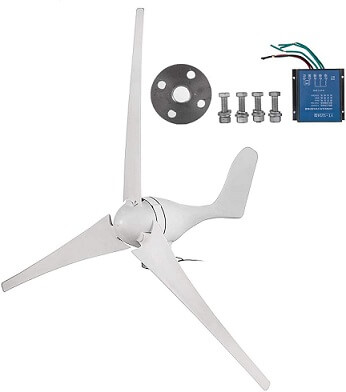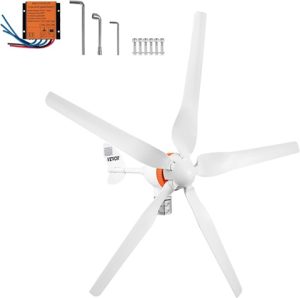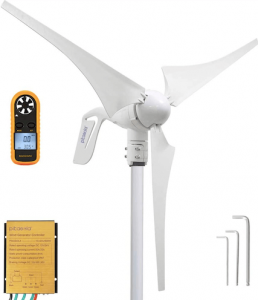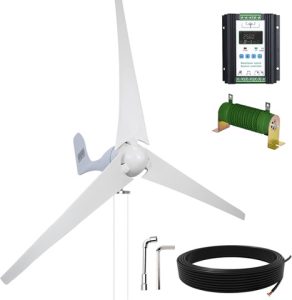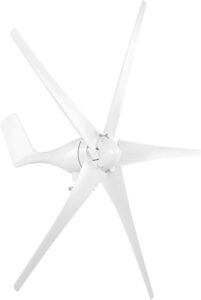Home wind turbines are a game-changer for anyone looking to reduce electricity bills and make a positive impact on the environment. The challenge, though, comes in choosing the right one amidst a sea of options, each with its own set of features and specifications.
To guide you through this, we have rigorously tested various models, focusing on three essential factors.
Here’s what you should know before you buy one:
- Power Generation Capacity: Pick a size from small (400 watts) to large (100 kilowatts) based on your power needs.
- Number of blades: Choose among the available options of three, four, or five blades. Remember that more blades can catch more wind but might cost more, while fewer blades are cheaper but might not grab as much wind.
- Size: Remember that taller and larger turbines catch more wind and generate more power. However, consider local rules, the size of your property, and surrounding buildings to pick a turbine that’s safe, legal, and fits well in your space
- SHZOND Home Wind Turbine – Best Overall
- VEVOR Home Wind Turbine – High Quality Efficient Generator
- Pikasola Home Wind Turbine – Best Budget-Friendly
- ECO-Worthy Home Wind Turbine – Designed for Both Land and Marine Uses
- Garosa Home Wind Turbine – High Wind Energy Utilization Rate
Best Home Wind Turbines Table
| Home Wind Turbines | Wattage Rating | Blade Count | Buy Now |
|---|---|---|---|
| Shzond Home Wind Turbine | 400 watts | 3 blades | Check On Amazon |
| VEVOR Home Wind Turbine | 500 watts | 5 blades | Check On Amazon |
| Pikasola Home Wind Turbine | 400 watts | 3 blades | Check On Amazon |
| ECO-Worthy Home Wind Turbine | 400 watts | 3 blades | Check On Amazon |
| Garosa Home Wind Turbine | 1600 watts | 5 blades | Check On Amazon |
Best Home Wind Turbines Reviews
1. Shzond Home Wind Turbine
Why it Made the Cut: Efficient power utilization, easy installation.
The SHZOND Wind Turbine is tailor-made for residential use, providing a solid 400W capacity ideal for various recreational settings like boats, gazebos, and chalets. Crafted with durable glass fiber blades and a focus on user safety, this turbine maximizes wind capture while maintaining a lightweight design and minimal vibration during use. Its simple DIY installation process enables users to easily set up the turbine for efficient energy production.
Specifications
- Rated Power: 400W
- Rated Voltage: DC27-54V
- Battery Voltage: DC12V
- Start-up Wind Speed: 2.5m/s
- Rated Wind Speed: 12m/S
- Number of Blades: 3
- Material of Wind Leaf: PBT
- Rotor Diameter: 1.2m
- Rated Speed: 800r/min
- Tower Diameter: >80 mm
- Tower Height: 4.5m-10m
- Battery Capacity: 200AH-400AH
- Certification: CE, RoHS, ISO9001
- Controller Model: FWS03/06-12
- Largest Discharging Current: 20A
- Working Temperature: -35~+75℃
Pros
- High wind power utilization.
- Easy installation and maintenance.
- Lightweight and low vibration operation.
- Suitable for various leisure settings.
Cons
- May require additional accessories for specific setups.
2. VEVOR Home Wind Turbine
Why it Made the Cut: Efficient power generation, versatile applications.
Vevor turbine, with a wattage of 500W, offers a lightweight design constructed from stainless steel and nylon fiber blades, ensuring both durability and efficiency. With a low start-up speed of merely 2 m/s, it adeptly adapts its direction to optimize wind energy capture, thereby guaranteeing consistent power generation. The turbine’s ease of assembly is facilitated by the pre-installed hoop and meticulously designed blades and hub, rendering it suitable for a diverse array of settings, including marine environments, motor homes, and chalets.
Specifications
- Rated Power: 500W
- Rated Voltage: 12V/24V (Auto)
- Rated Current: 29A
- Hoop Diameter: 54mm
- Rotor Diameter: 1.2m
- Rated Wind Speed: 13m/s
- Survival Wind Speed: 50m/s
- Rated Speed: 900r/min
Pros
- Efficient power generation with a low start-up speed.
- Lightweight and durable construction.
- Easy assembly with pre-installed hoop.
- Versatile applications including marine and motor homes.
Cons
- Issues with power output.
3. Pikasola Home Wind Turbine
Why it Made the Cut: High efficiency, versatile charging options.
For those seeking top-notch performance and reliability, the PIKASOLA 400W wind turbine is the ideal solution. Featuring a three-phase permanent magnet synchronous motor and carbon fiber blades made of nylon, it efficiently captures wind energy while keeping vibrations to a minimum. Equipped with a 30A Hybrid Charge Controller, this system ensures smart battery management, preventing overcharging and allowing smooth integration with solar panels. With its user-friendly design including a yaw adjustment mechanism for automatic wind direction optimization, it’s perfect for various residential and marine uses.
Specifications
- Rated Power: 400W
- Maximum Power: 410W
- Rated Voltage: 12V
- Start-up Wind Speed: 2.5m/s
- Rated Wind Speed: 13m/s
- Working Speed: 3-25m/s
- Survival Wind Speed: 40m/s
- Wind Wheel Diameter: 51.18 inches
- Blade Material: Nylon Fiber
Pros
- High efficiency with a three-phase motor.
- Versatile charging options with hybrid controller.
- Automatic wind direction adjustment for optimal performance.
- Durable construction with aluminum and stainless steel.
Cons
- Issues with controller compatibility.
4. ECO-Worthy Home Wind Turbine
Why it Made the Cut: Low start-up speed, maintenance-free design.
Featuring a modest starting speed of 5.6mph, this ECO-WORTHY turbine guarantees steady power generation even in moderate wind situations. Its trio of strengthened nylon fiber blades guarantees longevity, low noise levels, and diminished vibration while in use. Coupled with a 40A PWM Hybrid Controller, this package offers effective battery safeguarding. It is crafted with carbon fiber composite and cast aluminum components, demanding little upkeep. This makes it suitable for a range of environments, rendering it an ideal option for tasks like monitoring systems, street lighting, and marine installations.
Specifications
- Rated Power: 400W
- Start-Up Speed: 5.6mph (2.0m/s)
- Blade Material: Nylon Fiber
- Controller: 40A PWM Hybrid Controller
- Battery Type: 12V
Pros
- Low start-up speed ensures power generation in moderate winds.
- Maintenance-free design with durable materials.
- Efficient battery protection with PWM Hybrid Controller.
- Suitable for various applications including marine use.
Cons
- Limited instructions for setup and installation.
5. Garosa Home Wind Turbine
Why it Made the Cut: Slow start-up speed, stable power generation.
Garosa Wind Turbine Generator 1600W is a dependable solution for consistent power generation. This turbine is designed with a slow start-up speed and efficient wind energy utilization, ensuring steady power output even in light wind conditions. Its 5-blade design, crafted from durable nylon fiber, minimizes vibration and simplifies installation, making it ideal for a range of uses such as on boats, terraces, cabins, and mobile homes. The permanent-magnet rotor alternator, coupled with a specially designed stator, enhances reliability, while the automatic wind direction adjustment system maximizes energy capture for optimal performance.
Specifications
- Rated Power: 1600W
- Start-Up Wind Speed: 2.0m/s
- Rated Wind Speed: 12m/s
- Survival Wind Speed: 50m/s
- Blade Material: Nylon Fiber
- Generator: 3-Phase AC Permanent Magnet Synchronous Generator
Pros
- Slow start-up speed ensures power generation in low wind conditions.
- Stable power generation with low vibration operation.
- Easy installation and maintenance.
- Versatile applications including marine use.
Cons
- Performance inconsistency.
Factors To Consider When Choosing A Home Wind Turbine
Selecting the appropriate home wind turbine requires thoughtful evaluation of various important factors to ensure it performs well and meets your needs. Factors like wattage rating and blade count are essential in determining how efficiently the turbine can harness wind energy. In the following section, we’ll discuss the key considerations to keep in mind when choosing the right home wind turbine for your property.
1. Wattage Rating
The wattage rating is one of the key things to think about. This rating tells you the maximum power the turbine can generate, which helps you figure out if it’ll cover your energy needs. Before you buy, take a look at how much energy your household uses and pick a turbine with a wattage rating that matches up. Keep in mind that turbines with higher wattage can produce more electricity but might cost more. So, it’s important to find a balance between power and price.
2. Blade Count
Wind turbines usually have three, four, or five blades, and each option has its pros and cons. More blades mean more surface area, which helps capture more wind and produce more power. However, these turbines might be heavier and pricier. On the flip side, turbines with fewer blades can be lighter and cheaper but might not capture as much wind energy. To make the right choice based on blade count, consider factors like wind speed, noise, and installation needs for optimal performance.
3. Size and Height
The efficiency and effectiveness of a home wind turbine are influenced by its size and height. Generally, taller turbines perform better because they can reach stronger and more consistent winds at higher elevations. Moreover, larger turbines with longer blades can harness more wind energy, leading to increased power output. However, it’s essential to take into account zoning regulations, property size, and nearby structures when deciding on the size and height of your turbine. Selecting the appropriate size and height is vital to maximize energy production while minimizing safety concerns and visual impact.
4. Noise Level
It’s essential to think about noise levels, especially if you live near neighbors or residential areas. Even though most modern turbines are built to be quiet, some models might still make noise, especially in strong winds. When assessing turbines for noise, look at things like blade design, rotor size, and tower construction. Choosing a turbine with low noise can maintain a calm living space while using wind power.
5. Installation Requirements
Before you buy a home wind turbine, it’s important to check if your property meets the installation criteria. Things like local rules, the size of your property, how the wind blows, and the soil type can affect if a turbine can be installed. Also, think about the costs and how tricky the setup might be, including the need for a good base, building a tower, and sorting out the wiring. By checking all these factors beforehand, you can steer clear of problems and make sure putting up the turbine goes smoothly.
6. Maintenance Needs
Wind turbines need regular upkeep to work well and last long. This could mean things like checking and greasing moving parts, inspecting electrical connections, and doing routine cleaning and tweaks. Before you buy, make sure you know the manufacturer’s maintenance schedule and what’s needed to take care of your turbine properly in the long run.
Home Wind Turbine – FAQs
Ans: The amount of electricity generated depends on factors like wind speed and turbine size, but a typical turbine can produce anywhere from 400 to 1600 watts.
Ans: Modern turbines are designed to operate quietly, but some noise may be noticeable during high wind speeds. Opt for turbines with low noise emissions for a peaceful environment.
Ans: Yes, most home wind turbines can be connected to your existing electrical system to supplement or offset your energy usage.
Ans: Yes, home wind turbines can be installed in a variety of climates, but factors like wind patterns and temperature extremes should be considered during installation.
Ans: Yes, excess energy can be stored in batteries or fed back into the grid through a process called net metering, depending on your setup and local regulations.
Ans: Yes, multiple turbines can be installed to increase energy production, but factors like spacing and wind patterns should be considered to avoid interference.
Conclusion
Picking the right home wind turbine involves thinking about factors like its wattage rating, blade count, size, noise level, installation needs, and maintenance. By comparing these factors with your energy needs, budget, and property features, you can choose wisely to get the most energy with the least hassle. Using wind power is a green and sustainable option, helping you cut down on your carbon emissions and support a cleaner environment. Make a smart choice and enjoy the benefits of renewable energy for years ahead.

